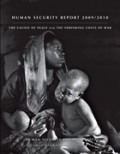
The Human Security Report 2009/2010 argues that long-term trends are reducing the risks of both international and civil wars. The Report, which is funded by the governments of Canada, Norway, Sweden, Switzerland, and the United Kingdom, also examines recent developments that suggest the world is becoming a more dangerous place. The Human Security Report 2009/2010 argues that long-term trends are reducing the risks of both international and civil wars. The Report, which is funded by the governments of Canada, Norway, Sweden, Switzerland and the United Kingdom and will be published by Oxford University Press, also examines recent developments that suggest the world is becoming a more dangerousplace. These include the following:--Four of the world's five deadliest conflicts--in Iraq, Afghanistan, Pakistan, and Somalia--involve Islamist insurgents.--Over a quarter of the conflicts that started between 2004 and 2008 have been associated with Islamist political violence.--In the post-Cold War period a greater percentage of the world>'s countries have been involved in wars than at any time since the end of World War II.--Armed conflict numbers increased by 25 percent from 2003 to 2008 after declining for more than ten years.--Intercommunal and other conflicts that do not involve a government increased by more than 100 percent from 2007 to 2008.--The impact of the global economic crisis on developing countries risks generating political instability and increasing the risk of war.--Wars have become "intractable"--i.e., more difficult to bring to an end. OverviewPart I - The Causes of PeaceIntroductionChapter 1: Why International Wars Are Increasingly RareChapter 2: The Causes of War and Peace: A Nontechnical Guide to Recent Research FindingsChapter 3: The East Asian Peace: Explaining the Remarkable Decline in Political Violence in Northeast and Southeast AsiaChapter 4: The Decline in Civil WarsPart II - The Shrinking Costs of WarIntroductionChapter 5: Deadly Connections: Wartime Violence and <"Indirect Deaths>"Chapter 6: The Paradox of Mortality Rates that Decline in Wartime Chapter 7: The Death Toll in the Democratic Republic of the Congo Chapter 8: Can Retrospective Mortality Surveys Be Used to Determine Excess Death Tolls? Chapter 9: Armed Conflict and Health PolicyPart III - Trends in Human InsecurityIntroductionChapter 10: State-based Armed ConflictChapter 11: Non-State Armed ConflictChapter 12: Assaults on Civilians
- ISBN: 978-0-19-986081-4
- Editorial: Oxford University
- Encuadernacion: Rústica
- Páginas: 128
- Fecha Publicación: 13/10/2011
- Nº Volúmenes: 1
- Idioma: Inglés
